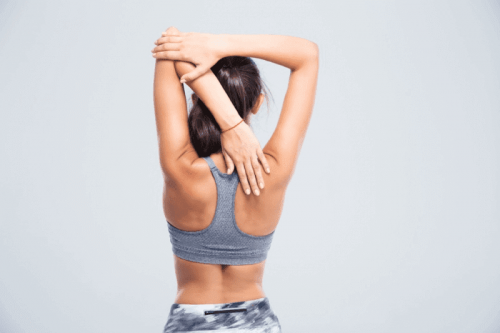How to Correct Droopy Shoulder Syndrome

Droopy shoulder syndrome is a postural problem that affects a large number of people. However, it’s not just bad posture that affects your upper back and shoulders. This condition can lead to problems in other areas of your body, and sometimes it’s even associated with your emotions and self-esteem.
Do you know what droopy shoulder syndrome is and how to correct it?
Keep reading, as we’re about to tell you how it happens, what factors are involved in it, and what kind of exercises you can do to treat it.
What’s droopy shoulder syndrome?
Droopy shoulder syndrome is a postural dimorphism in which the shoulders tend to lean forward, pushing the head down. People with this problem have a posture in which they seem to be permanently looking at the ground.
This posture doesn’t only affect the shoulders; in fact, it pushes the back progressively forward. Thus, a hump appears – this is also known as dorsal kyphosis. In addition, it affects the pectorals and the neck.
Though it may seem obvious, maintaining your back and shoulders straight isn’t just a matter of physical health, but also a reflection of the level of your self-esteem.
Many women who are ashamed of their breasts tend to adopt this position to try to hide them. Most of the time, they do so subconsciously. This is just one example of a possible psychological cause, however. There are many other issues that can lead a person into a hunched down posture, such as depression.
Unfortunately, this hunched-down position is becoming increasingly common. This is partly due to the excessive use of computers and electronic devices. The constant attention we give to our cellphones and computers makes us adopt this posture.
You may be interested: Eight Reasons for Shoulder Pain and How to Treat It
The effects of droopy shoulder syndrome

Maintaining a hunched-forward posture for long periods of time leads to back pain, both low back, and cervical pain. It’s also unsightly, as it makes you seem shorter and even makes your belly look larger than it is. Some even say that when a person stands tall, they seem a lot more self-assured and seem more attractive.
Additionally, keeping up a droopy shoulder position decreases your flexibility. In fact, it alters your joint movements as well as your balance. It can also lead to breathing and digestive problems.
Thus, you must try to correct this bad posture both while you rest and in motion. It’s important that you try to walk upright and with your head high. Likewise, you should also be aware of and correct your posture when you work.
You might like: Eleven Exercises to Help Rid of Shoulder pain
Tips to correct droopy shoulders

There are many stretching exercises that can help you to gradually correct droopy shoulder syndrome. These include:
- Shoulder external rotation. The goal is to take the shoulders back and hold them in the correct posture. To do so, push back your shoulders for 30 seconds. Repeat five times. If possible, do this exercise several times a day.
- Shoulder blade rotation. This one is about stretching the shoulder blades by pulling out the chest and bringing the shoulders back. It’s similar to the previous exercise except that you must bring your shoulder blades as close as possible when you bring your shoulders back. Hold it for 30 to 40 seconds and repeat it five more times. This will also relieve your back.
- Chest stretches. There are several ways to do these. One of them is to stand in front of a door and form a T with your arms. Then, bend your elbows and raise your forearms to “support” the door frame. You should feel your muscles stretch as soon as you take one step forward. Hold it for 30 seconds and repeat 5 times.
- Backstretches. One way to do this is to lie on your back and bring one knee to your chest. Stay like this for a few seconds and then do the same with the other leg. Another way to do it is to lie on your back and stretch one arm up and the opposite leg down at the same time. Both exercises will greatly relieve your back.
Final notes
As we mentioned before, droopy shoulders may be the result of low self-esteem. This is why it’s quite typical in shy or self-conscious people and even of those who are chronically depressed. In these cases, it’s not just enough to stand up tall but you must also treat the causes. To do so, it’s a good idea to seek therapy.
If you have droopy shoulders you must consult a physiotherapist who can advise and help you. It’s important that you’re aware of how it can lead to other physical problems. Remember, it’s never too late to improve your posture – and your overall health.
All cited sources were thoroughly reviewed by our team to ensure their quality, reliability, currency, and validity. The bibliography of this article was considered reliable and of academic or scientific accuracy.
- Abdul-Latif AA. Dropped shoulder syndrome: a cause of lower cervical radiculopathy. J Clin Neurol. 2011;7(2):85–89. doi:10.3988/jcn.2011.7.2.85
- van der Windt DA, Koes BW, de Jong BA, Bouter LM. Shoulder disorders in general practice: incidence, patient characteristics, and management. Ann Rheum Dis. 1995;54(12):959–964. doi:10.1136/ard.54.12.959
- Linaker CH, Walker-Bone K. Shoulder disorders and occupation. Best Pract Res Clin Rheumatol. 2015;29(3):405–423. doi:10.1016/j.berh.2015.04.001
- Straker LM, O’Sullivan PB, Smith A, Perry M. Computer use and habitual spinal posture in Australian adolescents. Public Health Rep. 2007;122(5):634–643. doi:10.1177/003335490712200511
- Kim D, Cho M, Park Y, Yang Y. Effect of an exercise program for posture correction on musculoskeletal pain. J Phys Ther Sci. 2015;27(6):1791–1794. doi:10.1589/jpts.27.1791
This text is provided for informational purposes only and does not replace consultation with a professional. If in doubt, consult your specialist.








